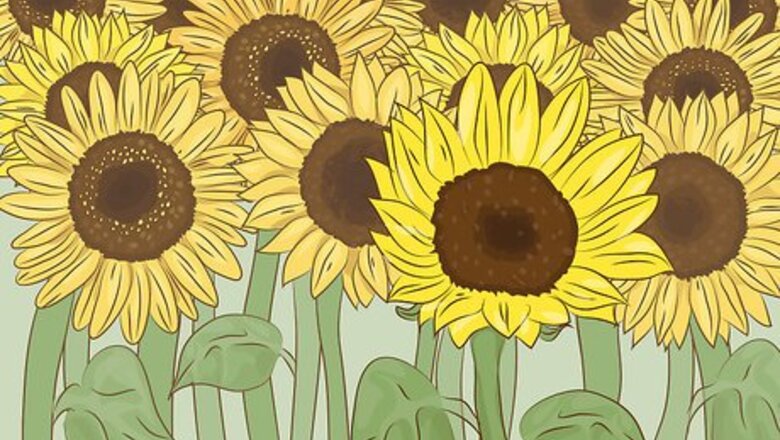
views
Drying Sunflowers for Decorating

Harvest partially open sunflowers. If you intend to dry sunflowers for decorative purposes, it is better to use small- to medium-sized sunflowers that have only just begun to open. The seeds have not fully developed, so they should not fall out after being dried.

Cut your flower with a decent-sized stem. The stem should be about 6 inches (15 centimetres) in length, so cut your flower accordingly. Pick a pretty, symmetrical bloom, and pull off any dead leaves around the head of the sunflower.

Hang the sunflower up to dry in a dark, dry place. Tie yarn or kitchen twine to the bottom of the stem. You can bundle them in threes, but the heads shouldn't touch. Pick a dark, dry place to hang them, such as an unused cabinet, a closet, or an attic. You can also set the flowers in a vase to dry. The petals will arch more gracefully. Still place them in a dark, dry place.

Check on the flowers in two weeks. The sunflowers should be dry in about two weeks, but they may take as long as three weeks. When they're dry, cut down the twine and pull them out of the closet.
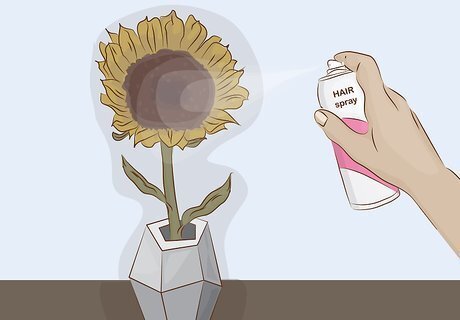
Coat the sunflowers with hairspray. Preserve the color and shape of the flower by spraying it with hairspray. Use them in vases or cut the stems short to place them in shadow boxes.
Drying Sunflowers with Drying Agents

Cut the stem short. When drying with a drying agent, it's best to shorten the stem to 1 inch (2.5 centimetres) to 2 inches (5.1 centimetres), as stems can be brittle after drying. If you want a longer stem, create a stem with floral wire while the flower is still fresh. Push the floral wire up through the stem. Bend it back down, and pull it back through the stem. Wrap the wire around itself.

Mix cornmeal with borax. Borax and cornmeal will work together to dry out your sunflowers. Mix it together in equal parts. To help keep the color, add a spoonful or so of salt to the mixture.
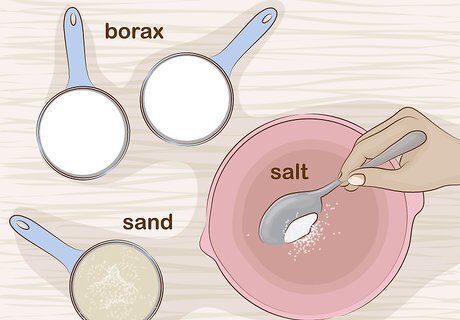
Add two parts borax to one part sand. This mixture will also help dry out your flowers. Stir in a spoonful of salt to preserve the color. This mixture is heavier, though, and may smoosh your flowers a bit.
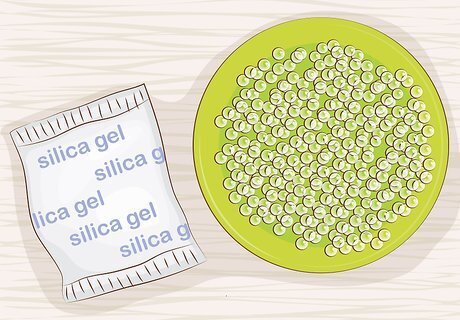
Try silica gel. Another option is simply using silica gel. Silica gel is what comes in those "Do not eat" packets in shoes, purses, and sometimes, food, but you can also buy it online or at craft stores. It dries things faster than the other mixtures, so you don't need to add salt to preserve the flower's color.
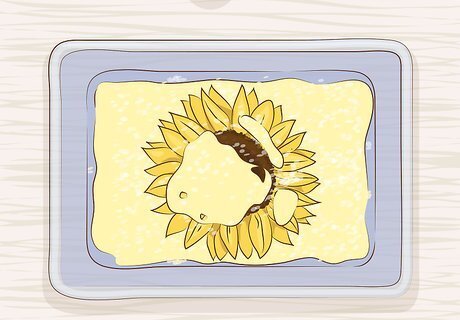
Create your drying container. Use a container with a tight lid, particularly with silica gel. Place about 1 inch (2.5 centimetres) of the drying agent in the bottom. Place the sunflowers face up in the container. Gently sprinkle the drying agent over the flowers until they are covered, and put the lid on.
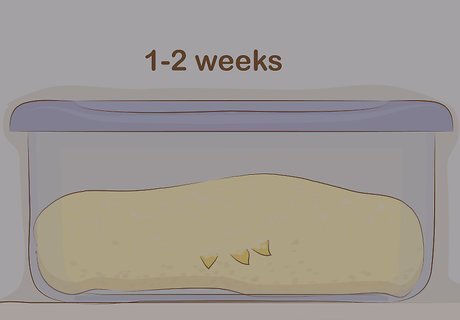
Put the container in a warm, dry area. Just like when you're hanging flowers, you need to set the container somewhere warm and dry to help the sunflowers dry. The sunflowers in the silica gel should be done in less than a week. The flowers in the other drying agents will take a week or two.
Drying Sunflowers for Seeds

Allow the sunflowers to mature in the ground. As long as the weather is still warm and dry, you should let the sunflowers reach full maturity while still growing. If possible, do not cut the flower heads off before the back turns yellow-brown. Ideally, you should wait until the sunflower loses its petals and the head droops. You might need to tie the flower head to a stake as it begins to die and droop, though. The head will become heavier, and the plant will begin to weaken under its own weight.

Protect the seeds from birds with cheesecloth. Wrap cheesecloth or even a paper bag around the flower heads and tie it on with kitchen twine. Doing so will protect the seeds from birds and squirrels, and it will also catch seeds that may fall off. Wait until after the flower starts to die and droop before covering the flower head.

Cut the sunflower stem at an angle. If you need to cut the flower heads off early due to pests or climate, cut off about 1 foot (30 centimetres) of the stem along with it, and hang the plants upside down inside to dry until the back of the flower head turns completely brown.

Remove seeds after several weeks. Once the flowers have completely dried, you should be able to remove the seeds simply by brushing them off with your fingers or with a stiff brush. You can also use a fork. If you have multiple sunflowers, you can also remove the seeds by rubbing two sunflower heads together.

Prepare the sunflower seeds for eating. Mix a cup of salt into a gallon of water. Pick through the seeds to remove any flower or extra plant bits, and then pour them into the water. Soak them for eight hours or more. Once they've soaked, strain the seeds, and spread them out on a pan. Place them in a 425 degrees Fahrenheit (218 degrees Celsius), and let them dry for about five hours. Put them in an airtight container, and stick them in the freezer to store sunflower seeds for up to a year.
Drying Sunflower Petals

Collect the petals. Choose a sunflower with bright, undamaged petals and pluck these petals off one by one using your fingers. Try not to damage the petals as you pull them off.

Dry petals with pressure. Place the petals in a single layer between two sheets of blotting paper, parchment paper, or paper towels (blotting paper is the best option). Place the sheets between two pieces of cardboard. Set a heavy book on top, and let the petals dry for several weeks. You can also simply place the paper towels or blotting paper between pages in a heavy book.
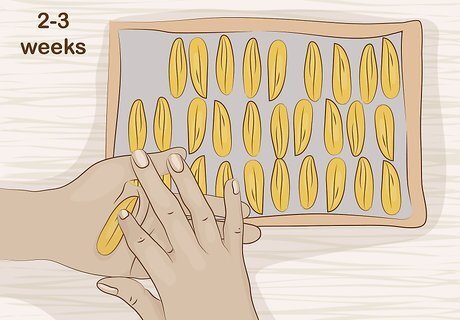
Check the petals. After two or three weeks, remove the cardboard and blotting paper carefully and pick the petals up gently. If the petals still feel moist, lay out new blotting paper and continue pressing them for another week or so before checking them again.
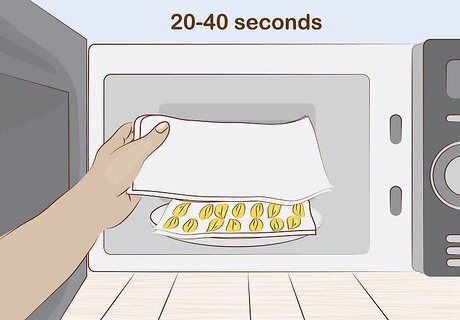
Dry petals in the microwave. Lay out two sheets of paper towel on a microwave-safe plate. Arrange the petals in a single layer on top of these paper towels, then place another two sheets of clean paper towels on top of the petals. Microwave the petals on high power for 20 to 40 seconds or until the petals completely dry out. The paper towels will wick away the moisture released by the sunflower petals as you microwave them.

Check the sunflower petals after the first 20 seconds. If they still fill damp, continue microwaving them in 10 second intervals until they feel dry. Do not let the petals become crisp, though.
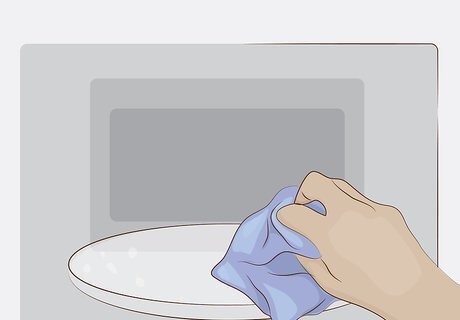
Dry the plates and switch out the paper towels in between batches. You could also let the paper towels sit out for a few minutes to let them dry instead of using new paper towels. You should let the petals rest on your paper towels for several hours before you use them, which helps with preservation.












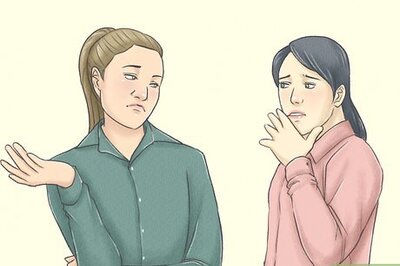



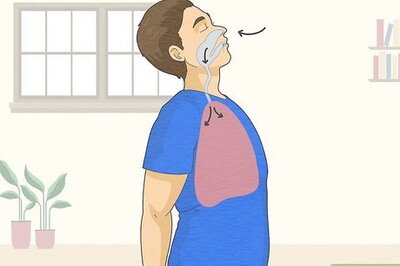


Comments
0 comment